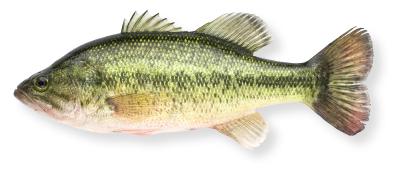Largemouth Bass
Micropterus salmoides
 Distribution: Largemouth bass are native to the Mississippi drainage and the coastal watersheds of the southeastern United States. It has been widely introduced into the water bodies of New Hampshire and is now common.
Distribution: Largemouth bass are native to the Mississippi drainage and the coastal watersheds of the southeastern United States. It has been widely introduced into the water bodies of New Hampshire and is now common.
Description: The largemouth bass is elongated and laterally compressed with a mouth that extends past the rear edge of the eye. It has a horizontal black streak, either continuous or broken into blotches, along each side and a large powerful tail. Its scales are larger than those of the smallmouth bass. Coloration is generally green along the back, fading to silvery white below. Unlike the smallmouth bass, there are no scales at the base of the anal and dorsal fins
Species commonly confused with: Smallmouth bass
Habitat: Largemouth bass prefer weedy backwaters, ponds, and lake shores with aquatic vegetation and a muddy bottom. They are often associated with golden shiners, brown bullheads, chain pickerel, and bluegill.
Life History: Like the other members of the sunfish family, largemouth bass males defend a nest in shallow water during the spring. Nest predation is a major cause of mortality and a male largemouth will aggressively attack anything that moves within 6 feet of its nest. Males will continue to defend their fry for up to two weeks or until they disperse from the nest area. Largemouth bass fry feed on zooplankton until they reach about 2 inches in length, after which they begin to shift toward a diet of fish. Prey is swallowed whole, with larger bass generally consuming larger fish. As visual predators, largemouth bass ambush their prey among stands of aquatic vegetation. Their tendency to react to sudden movement makes them vulnerable to artificial lures.
Largemouth bass have a higher tolerance for warm temperatures than smallmouth bass. They may be found in shallow water well into the summer after smallmouth bass have moved into deeper water away from shore. Largemouth bass become less active and seek out deeper water during the colder months. In northern climates, largemouth bass can reach 15 years of age. The record largemouth bass taken by angling in New Hampshire was 10.5 pounds.
Origin: Introduced
Conservation/Management: Largemouth bass are fierce predators known to displace native species and alter aquatic ecosystems when introduced into waterbodies outside of their historic range. Largemouth bass have become naturalized in most New Hampshire waters, where they have become very popular with anglers. Their eradication is neither possible nor desirable. However, further spread of bass should be prevented to protect the remaining habitat for vulnerable native fish species.



